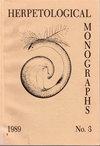新生爬行动物生长的能量消耗
IF 1.1
2区 生物学
Q3 ZOOLOGY
引用次数: 71
摘要
幼小的爬行动物会避免为快速生长付出代谢代价吗?生长中的哺乳动物和鸟类除了不生长时的代谢消耗之外,还必须消耗额外的能量来合成新的组织。这一合成成本还不包括生长动物为寻找、消耗、消化和分配额外食物所需的其他成本,这些额外食物是它们生产新身体物质所需要的。因此,可以合理地假设,自由生活的新生和幼年陆生脊椎动物一般具有基础(标准)和野外代谢率和摄食率,高于相同体重的(非生长)成年动物的预期代谢率和摄食率。哺乳哺乳动物和初生的早熟鸟类确实具有相对较高的基础代谢率。然而,在爬行动物中,目前关于新生儿标准代谢率(SMR)的可用数据表明,与成年SMR相比,新生儿的标准代谢率没有显著增加。在野外,由于额外的生长相关成本的代谢增量应该相对较大,因此在新生爬行动物中很容易检测到。迄今为止,已经测量了10种爬行动物的幼崽和幼崽的野外代谢率(FMR): 3种毛蜥、3种皮蜥、2种鬣蜥、1种龙骨蜥和1种龟类。在校正了体重差异(使用mass0-80)后,新生蜥蜴的代谢率与同时在自由生活的成年蜥蜴中测量的代谢率相似。龟(Gopherus agassizii)幼鱼的能量消耗也没有明显增加。应该对爬行动物幼崽的SMR进行更仔细的测量,以确定爬行动物是否不像哺乳动物幼崽和早熟鸟类那样,在生长过程中缴纳巨大的能量“税”。雏鸟在孵化后一段时间内是恒温的,SMR较低,对雏鸟的研究也可能对这方面有指导意义。需要对新生爬行动物的时间活动预算进行实地研究,以确定它们如何在快速生长的同时实现如此低的野外代谢率。在活动期间,新生儿的平均体温是否较低?新生儿每天活动的时间比成年人少吗?幼崽利用微生境资源的方式是否会减少与成虫的种内竞争,但无论如何都能实现快速生长?新生儿的消化、代谢和生长的热依赖性是否不同,从而使他们能够在较低的日常综合体温下良好地运作并迅速生长?本文章由计算机程序翻译,如有差异,请以英文原文为准。
ENERGY COSTS OF GROWTH IN NEONATE REPTILES
Do young reptiles avoid paying the metabolic costs of rapid growth? Growing mam- mals and birds must spend extra energy, beyond the metabolic costs they have when not growing, to pay the cost of synthesizing new tissues. This synthesis cost is in addition to the other costs that growing animals pay to forage for, consume, digest and allocate the extra food they need to produce new body substance. Thus, it is reasonable to hypothesize that free-living neonate and juvenile terrestrial vertebrates in general will have basal (standard) and field metabolic rates and feeding rates that are higher than expected for (non-growing) adults of the same body mass. Suckling mammals and neonate precocial birds do have relatively high basal metabolic rates. Among reptiles however, currently available data on standard metabolic rates (SMR) of neonates indicates no sig- nificant increment over adult SMR. In the field, metabolic increments due to the additional growth- associated costs should be relatively large and hence readily detectable in neonate reptiles. To date, the field metabolic rates (FMR's) of neonates and juveniles have been measured in ten species of reptiles: three phrynosomatid lizards, three lacertid lizards, two iguanid lizards, one agamid lizard, and one chelonian. The neonate lizards all had metabolic rates that were similar to those measured simultaneously in free-living adults, after correction for body mass differences (using mass0-80). The chelonian (Gopherus agassizii) juveniles also showed no obvious increment in energy expenditure over adults. More careful measurements of SMR in neonate reptiles should be done to determine if reptiles are free of the large energetic "tax" on growth that is paid by neonate mammals and precocial birds. Studies of neonate altricial birds, which are ectothermic for some time after hatching and have low SMR's, also may be instructive in this regard. Field studies of neonate reptile time- activity budgets are needed to determine how they achieve such low field metabolic rates while simultaneously growing rapidly. Do neonates have lower body temperatures on average during their activity period? Do neonates spend less time active each day than adults? Do neonates use micro- habitat resources in ways that reduce intraspecific competition with adults, but allow for rapid growth anyway? Are the thermal dependencies of digestion, metabolism and growth different in neonates, thereby allowing them to function well and grow rapidly at lower daily integrated body temperatures?
求助全文
通过发布文献求助,成功后即可免费获取论文全文。
去求助
来源期刊

Herpetological Monographs
生物-动物学
CiteScore
5.40
自引率
0.00%
发文量
2
审稿时长
>12 weeks
期刊介绍:
Since 1982, Herpetological Monographs has been dedicated to original research about the biology, diversity, systematics and evolution of amphibians and reptiles. Herpetological Monographs is published annually as a supplement to Herpetologica and contains long research papers, manuscripts and special symposia that synthesize the latest scientific discoveries.
 求助内容:
求助内容: 应助结果提醒方式:
应助结果提醒方式:


